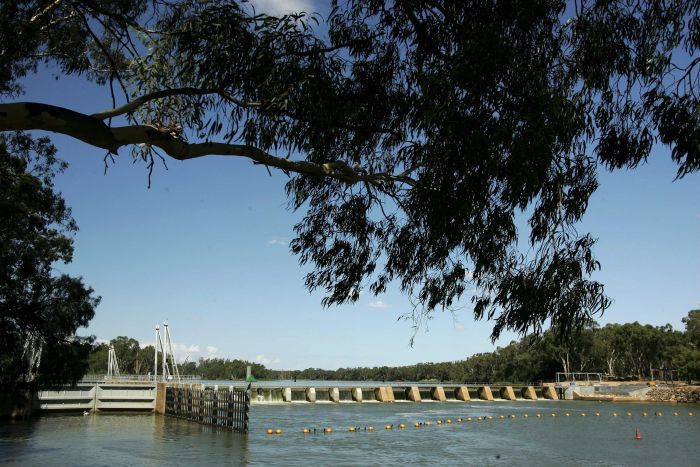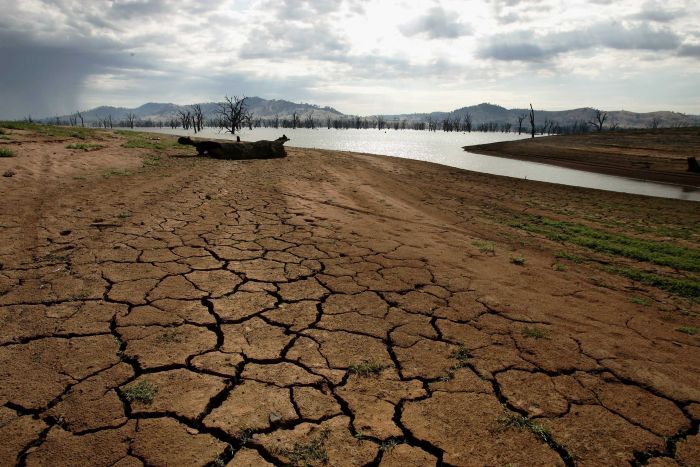John Howard's vision for the Murray-Darling hangs in the balance
Updated
 Photo:
For decades irrigators had been pumping more water out of the system than it had to give. (Getty Images: Auscape/UIG)
Photo:
For decades irrigators had been pumping more water out of the system than it had to give. (Getty Images: Auscape/UIG)
At a dinner celebrating the 20th anniversary of the election of the Howard government last year, Prime Minister Malcolm Turnbull reeled off John Howard's "roll call of achievements" — tougher gun laws, tax reform, economic management and "his great reform, of ensuring that the management of the Murray-Darling Basin came under federal leadership".
"This was something that should have been agreed to in the 1890s," Mr Turnbull observed. "John Howard saw that crisis of the drought 2006-2007, and never wasting a crisis, he saw the opportunity to make good an omission of more than a century ago."
The rivers had nurtured Australia's agricultural prosperity, but for decades irrigators had been pumping more water out of the system than it had to give.
By 2007, in the middle of the worst dry in recorded history, the rivers were in crisis. And with "the prospect of long term climate change, we need radical and permanent change," Mr Howard said.
It was time to fix the Murray-Darling "once and for all".
It would take another five years of political wrangling — and a Labor government — to finally lock in a historic bipartisan deal with the states in 2012 to return flow to the rivers. But somewhere in the final throes of negotiations, all the parties exploiting their last bargaining chips but exhausted by months of brinksmanship, a time bomb dropped into the fine print.
The 450GL ticking time bomb
The central legislated target of the Murray-Darling Basin Plan is to recover 2750GL of water a year from irrigators and give it back to the rivers — that's about five and a half times the volume of Sydney Harbour, a 25 per cent cut in irrigation flows.
In a last-minute deal to get South Australia on board, a further 450GL was written into the preamble of the plan, bringing the total to 3200GL, which was the figure scientists had settled on as the minimum required to give some chance of the rivers recovering health.
 Photo:
Mr Pell was surprised to learn that there was no community-wide test of the impact of recovering the extra 450GL. (Getty Images: Robert Cianflone/Staff)
Photo:
Mr Pell was surprised to learn that there was no community-wide test of the impact of recovering the extra 450GL. (Getty Images: Robert Cianflone/Staff)
The caveat attached to this extra 450GL was that it would be deliverable only if it didn't cause communities any further economic or social pain. Irrigators upstream were reassured by this clause.
As one Victorian dairy farmer closely involved in the deal, Russell Pell, told a recent Senate hearing sitting near his home ground in Shepparton, "for three years we tossed around what number to come up with, and after a considerable debate the figure of 2,750 was decided upon".
No more could be taken from irrigated industry without causing pain, they figured, and hence they would not have to deliver the extra 450GL.
Mr Pell told Background Briefing that his community had been surprised to learn recently that there was no community-wide test of the impact of recovering the extra 450GL, and that there appeared to be no constraint on individual farmers participating in schemes if they wished.
The timer on the ticking bomb of the extra 450GL was ignited last November when Deputy Prime Minister Barnaby Joyce wrote to South Australia saying that he didn't anticipate it could be delivered without causing pain to basin communities.
 Photo:
A lock and weir, which helps with navigation and facilitates irrigation and water supply. (Getty Images: Robert Cianflone)
Photo:
A lock and weir, which helps with navigation and facilitates irrigation and water supply. (Getty Images: Robert Cianflone)
After South Australian Water Minister Ian Hunter let rip at his state colleagues over the issue, Mr Turnbull moved to smooth waters by reassuring South Australia that the plan would be delivered "in full". But ambiguity in the framing leaves scope for disagreement on what that constitutes "full" — 2750GL, or 3200GL?
This week Labor's water spokesman — and the man who locked up the basin plan deal for the Gillard government in 2012 — Tony Burke announced that Labor was drafting an amendment to the plan that would compel delivery of the extra 450GL, which he insisted had always been part of the deal.
Review calls to wind back target
Meanwhile, there's also action — and increasing tension — at the northern end of the system.
It comes on the back of a review by the Murray-Darling Basin Authority on the impact of water recovery in southern Queensland and northern New South Wales, which had determined that some communities had suffered too much, and was now recommending that the 2750GL central target be wound back by 70GL to save around 200 jobs in the north.
The recommendation has inflamed the perennial and parochial rivalries of water politics. Irrigators seized on the review's findings as a vindication of their concerns that water recovery was costing them too much. Some at the top end of the system argued that the target should be pulled back even further.
Other farmers — including irrigators further down the system and graziers who feed their cattle on the floodplains — dug in to keep the plan on track.
Scientists and environmentalists protest any erosion in the plan's ambitions, arguing that it already short-changes the system on the flows it requires to be given a fighting chance of resilient health.
'Every gigalitre matters'
So far the authority that administers the plan has found 2000GL a year to give back to the river. Most has come through water buybacks — paying irrigators for their water entitlements — and through investment in water-saving infrastructure.
 Photo:
"The Murray-Darling River system is dying from the bottom up," James Pittock says. (Getty Images: Robert Cianflone/Staff)
Photo:
"The Murray-Darling River system is dying from the bottom up," James Pittock says. (Getty Images: Robert Cianflone/Staff)
The Commonwealth Environmental Water Holder, Mr David Papps — whose job is to deploy recovered water in ways that improves the system's health — told Background Briefing that while some improvements had been seen in environmental conditions, there was still "a fair way to go yet".
With the Murray-Darling Basin Authority winding up consultations on the recommendation to pull back on its water recovery ambitions, and political heat flaring the length of the 2500km system, there are fears the future of the fragile water sharing deal hangs in the balance.
"Every gigalitre matters, because the Murray-Darling River system is dying from the bottom up," said Associate Professor James Pittock of the Wentworth Group of Concerned Scientists.
"John Howard's vision for fixing the basin is at great risk. (He) rightly said we can't muck around here with compromise decisions — we have to fix it once and for all.
"What we have seen in the last few years is exactly the tyranny of incrementalism, where bite by bite, water is being taken away from the environment."
Hear Jo Chandler's full investigation for Background Briefing on Radio National at 8:05am on Sunday, or subscribe to the podcast on iTunes, ABC Radio or your favourite podcasting app.
Topics: rivers, environment, water-management, water-supply, environmental-impact, environmental-management, environmental-policy, joyce-barnaby, turnbull-malcolm, howard-john-winston, murray-darling-basin, australia, sa, qld, vic, nsw
First posted








